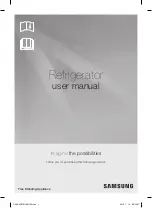
9
Remember to wash the defrost cleaner in hot soapy
water at regular intervals. Dry throughly before
replacing.
Freezer
When the frost has reached a thickness of up to
4mm it can be removed using the ice scraper
provided with the appliance. During this operation it
is not necessary to disconnect the appliance from
the mains and remove the food. Never use metal
tools for this operation.
For complete defrosting (once or twice a year)
proceed as follows:
- turn the thermostat dial to the ÇOFFÈ position (O)
or disconnect the appliance from the mains.
- Remove any food from inside the freezer and
fridge, wrap it in several sheets of newspaper and
store in a cool,dry place.
- Leave the door open and insert the ice scraper
under the channel in the centre of the lower part
of the appliance; place a low-sided container
beneath the scraper to collect the water (see fig.).
- Clean and dry thoroughly.
- Replace the scraper in one of the drawers .
- Reconnect the appliance to the mains or reset
the thermostat to a functioning position.
- After letting the appliance run for at least half an
hour, replace the food.
Important
When defrosting the freezer, the fridge is also
controlled by the thermostat and will not be
operational during this period. A temperature rise of
the frozen food packs, during defrosting, may
shorten their safe storage life.
Attention!
In the event of a power failure causing the
temperature within your freezer to rise, do not re-
freeze the food without checking its condition.
The following guidelines should assist you.
Ice-cream
: once thawed should be discarded.
Fruits & Vegetables:
if soft should be cooked and
used up.
Breads & Cakes
: can be re-frozen without danger.
Shellfish
: should be refrigerated and used up
quickly.
Cooked Dishes
: i.e. casseroles should be
refrigerated and used up.
Large Pieces of Meat:
can be re-frozen providing
there are still ice crystals remaining within them.
Small Joints
: should be cooked and can then be re-
frozen as cooked dishes.
Chicken
: should also be cooked and re-frozen as a
cooked dish.
D068/2
12




























